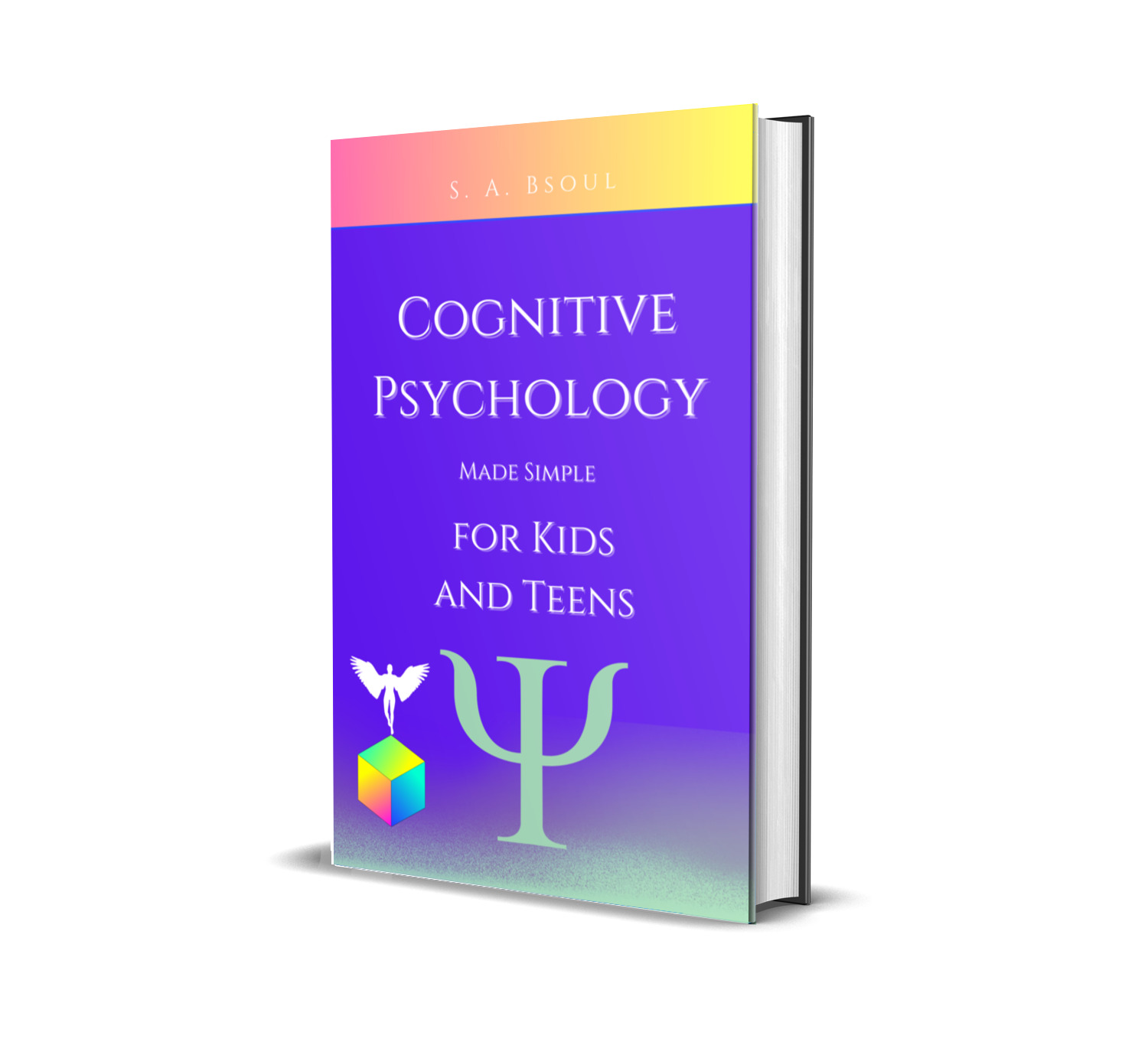Mind Over Myth: The Psychology Reality Check
Sami Bsoul, PhD
It is expected that I provide a few lines to convince you that this book is truly a good purchase and worth reading.
However, I will not do that. Instead, I'll share with you one belief of mine.

There's an approach that suggests people don't really know what they want, and you can put anything in front of them, and they'll buy it. I don't subscribe to this notion.
I believe people do know what kind of book they're seeking.
So, if you're reading these lines, it's likely because this book aligns with what you're looking for, or at least comes close to it.
If you've stumbled upon this book by coincidence, then I believe there are no coincidences in life, and everything has its meaning. Perhaps the universe brought you to this book.
I wrote this book out of passion for psychology, as a hobby, and with a desire to share knowledge rather than for making it a business venture.

If you were to ask me, do I believe this book brings something totally new? Yes, I do. Packed with hundreds of myths backed by facts and reality checks, this book offers a fresh perspective.
Do I believe this book is both humorous and entertaining? Oh dear, it definitely is. Brimming with humor, it boldly proclaims the profound impact of laughter on mental health. Indeed, prescribing laughter is far simpler than antidepressants. This book embodies the potency of positive affirmations in therapy.

Being too serious isn't good, but being too silly isn't great either. So, what's the right way? It's about finding a balance, not going too far one way or the other. And that's precisely what this book is all about.
Do I believe this book is suitable for all ages and everyone? Absolutely. It can be enjoyed by the most expert psychologists, psychiatrists, students of psychology, or anyone who has no clue about psychology. This book is for everyone, the whole family, regardless of age or gender. It's simply the book for everyone.

You know that one friend who always comes to you with these crazy things they just heard somewhere on the street or at some bar and tells you, 'Listen, I heard they say...'
Now, you've just been hit by your friend with some information that 'looks like fact' but actually is not, and on top of that, you never get to know who these people (they) that are saying stuff all the time?
Well, here's where this book comes in to smash down the myths around psychology and bring the facts. You can confidently say this book is a reality check.

So, the next time someone tells you, 'Listen, they say that...' you don't want to bother asking who 'they' are, just bring this book into their face.
When I decided to write this book, I was thinking about the saying that goes, 'Do not believe all what you hear and do not believe half of what you see.'

With everyone becoming a master of psychology just because they wrote a few positive quotes or studied all kinds of psychology posts on Instagram, it's no surprise that myths start to run faster than cheetahs and facts sink deep down into the social media turbulence.

This book is the most valuable and objective gift you can give someone.
It is complete with funny, original illustrations and jokes written especially for this book, it offers a delightful reading experience.
This book carefully examines myths versus facts, presenting them in a clear and accessible manner.
Through various styles and tones, it distinguishes between truth and falsehood, unveiling the reality behind common misconceptions in psychology.
Enjoy discovering the truth!
© Samibsoul.com 2024
Bsoul, S. (2024). Mind Over Myth: The Psychology Reality Check [Kindle Edition].
References:
Aaron, J. I., Mela, D. J., & Evans, R. E. (1994). The influences of attitudes, beliefs, and label information on perceptions of reduced-fat spread. Appetite, 22, 25–37.
Abler, W. (2013). Sapir, Harris, and Chomsky in the twentieth century. Cognitive Critique, 7, 29–48.
Abraira, V. E., & Ginty, D. D. (2013). The sensory neurons of touch. Neuron, 79, 618–639.
Abramson, L. Y., Metalsky, G. I., & Alloy, L. B. (1989). Hopelessness depression: A theory- based subtype of depression. Psychological Review, 96, 358–372.
Ader, R. & Cohen, N. (2001). Conditioning and immunity. In R. Ader, D. L. Felten & N. Cohen (Eds.), Psychoneuroimmunology (3rd ed., pp. 3–34). New York, NY: Academic Press.
Adler, A. (1930). Individual psychology. In C. Murchison (Ed.), Psychologies of 1930 (pp. 395–405). Worcester, MA: Clark University Press.
Ainsworth, M. D. S., Blehar, S., Waters, E., & Wall, S. (1978). Patterns of attachment: A psychological study of the strange situation. Hillsdale, NJ: Lawrence Erlbaum Associates.
Airenti, G. (2019). The place of development in the history of psychology and cognitive science. Frontiers in Psychology, 10, 895. https://doi.org/10.3389/fpsyg.2019.00895
Albarracín, D., & Wyer, R. S. (2001). Elaborative and nonelaborative processing of a behavior-related communication. Personality and Social Psychology Bulletin, 27, 691–705.
Alladin, A. (2012). Cognitive hypnotherapy for major depressive disorder. The American Journal of Clinical Hypnosis, 54, 275–293.
Alexander, J.J., Anderson, A.J., Barnum, S.R., Stevens, B., and Tenner, A.J. (2008). The complement cascade: Yin-Yang in neuroinflammation—neuro-protection and -degeneration. J. Neurochem. 107, 1169–1187.
Allen, L. S., & Gorski, R. A. (1992). Sexual orientation and the size of the anterior commissure in the human brain. Proceedings of the National Academy of Sciences, USA, 89, 7199–7202.
Allen, V. L. (1965). Situational factors in conformity. Advances in Experimental Psychology, 2, 133-175.
Alvarsson, J. J., Wiens, S. and Nilsson, M. E. (2010). Stress recovery during exposure to nature sound and environmental noise. Int. J. Environmental Research and Public Health 7, 3, 1036–1046. Amabile, T. M., Goldfarb, P., & Brackfield, S. (1990). Social influences on creativity: Evaluation, coaction and surveillance. Creativity Research Journal, 3, 6-21.
American Psychological Association. (2015a). Guidelines for psychological practice with transgender and gender nonconforming people. American Psychologist, 70(9), 832–864. https://doi.org/10.1037/a0039906
American Psychological Association. (2015b). Key terms and concepts in understanding gender diversity and sexual orientation among students. Retrieved from https://www.apa.org/pi/lgbt/programs/safe-supportive/lgbt/key-terms.pdf
American Psychological Association. (2019). Maime Phipps Clark, PhD, and Kenneth Clark, PhD. Retrieved from https://www.apa.org/pi/oema/resources/ethnicity-health/psychologists/clark
American Psychological Association of Graduate Students. (2015). Proud and prepared: A guide for LGBT students navigating graduate training. American Psychological Association. Retrieved from https://www.apa.org/apags/resources/lgbt-guide
American Psychological Association. (2010). Publication Manual of the American Psychological Association (6th ed.). Washington, D.C.: American Psychological Association.
American Psychological Association, Committee on Lesbian, Gay, and Bisexual Concerns Joint Task Force on Guidelines for Psychotherapy With Lesbian, Gay, and Bisexual Clients. (2000). Guidelines for psychotherapy with lesbian, gay, and bisexual clients. Washington, DC: Author. Retrieved from https://web.archive.org/web/20081022063811/http://www.apa.org:80/pi/lgbc/guidelines.html
American Psychological Association. (2018). APA Dictionary of Psychology. Retrieved from https://dictionary.apa.org/identity
Anderson, C. A., & Gentile, D. A. (2008). Media violence, aggression, and public policy. In E. Borgida & S. Fiske (Eds.), Beyond common sense: Psychological science in the courtroom (p. 322). Malden, MA: Blackwell.
Anderson, N. S. (1969). The influence of acoustic similarity on serial recall of letter sequences. Quarterly Journal of Experimental Psychology, 21(3), 248–255.
Anderson, R. C. (1984). Role of the reader's schema in comprehension, learning, and memory. In R. C. Anderson, J. Osborn, & R. J. Tierney (Eds.), Learning to read in American schools: Basal Readers and Content Texts (pp. 243–257). Hillsdale, NJ: Erlbaum.
Andrea, H.; Bültmann, U.; Beurskens, A.J.H.M.; Swaen, G.M.H.; van Schayck, C.P.; Kant, I.J. Anxiety and Depression in the Working Populationusing the HAD Scale. Soc. Psychiatry Psychiatr. Epidemiol. 2004, 39, 637–646.
Archbell, K., Coplan, R., Nocita, G., and Rose-Krasnor, L. (2019). Participation in structured performing arts activities in early to middle childhood: psychological engagement, stress, and links with socioemotional functioning. Merril Palmer Q 65, 329–335. doi: 10.13110/merrpalmquar1982.65.3.0329
Arnett, J. (2000). Emerging adulthood: A theory of development from the late teens through the twenties. American Psychologist, 55(5), 469–480.
Asch, S. E. (1956). Studies of independence and conformity: A minority of one against a unanimous majority. Psychological Monographs, 70(9, Whole No. 416).
Asexual Visibility and Education Network - Nonprofit Explorer. (2013, May 9).
Atkinson, R. C., & Shiffrin, R. M. (1968). Human memory: A proposed system and its control processes. In K. W. Spence & J. T. Spence (Eds.), The psychology of learning and motivation: Volume 2 (pp. 89–195). New York, NY: Academic Press.
Audia, P. G., & Goncalo, J. A. (2007). Success and creativity over time: A study of inventors in the hard-disk drive industry. Management Science, 53, 1-15.
Aviezer, O., Sagi, A., Resnick, G., & Gini, M. (2002). School competence in young adolescence: Links to early attachment relationships beyond concurrent self-perceived competence and representations of relationships. International Journal of Behavioral Development, 26(5), 397–409.
Ayabe-Kanamura, S., Saito, S., Distel, H., Martínez-Gómez, M., & Hudson, R. (1998). Differences and similarities in the perception of everyday odors: A Japanese-German cross-cultural study. Annals of the New York Academy of Sciences, 855, 694–700.
Baddeley, A. (2004). Your memory: A user's guide. Richmond Hill, Canada: Firefly Books.
Baddeley, A. D., & Hitch, G. (1974). Working memory. In G. H. Bower (Ed.), The psychology of learning and motivation: Advances in research and theory (Vol. 8, pp. 47–89). New York, NY: Academic Press.
Baer, M., Oldham, G. R., Jacobsohn, G. C., & Hollingshead, A. B. (2008). The personality composition of teams and creativity: The moderating role of team creative confidence. The Journal of Creative Behavior, 42(4), 255.
Baker, C. (2004). Behavioral genetics: An introduction to how genes and environments interact through development to shape differences in mood, personality, and intelligence. Washington, DC: American Association for the Advancement of Science.
Baker, L. A., Bezdjian, S., & Raine, A. (2006). Behavioral genetics: The science of antisocial behavior. Law and Contemporary Problems, 69, 7–46
Bakker, J., Pechenizkiy, M. and Sidorova, N. (2011). What’s your current stress level? Detection of stress patterns from GSR sensor data. Proc. IEEE 11th Int. Conf. Data Mining Workshops, Vancouver, Canada.
Bakermans-Kranenburg, M. J., (2016). Attachment, parenting, and genetics. In Cassidy, P., Shaver, J (Ed.), Handbook of attachment: Theory, research, and clinical applications (3rd ed., pp. 155–179). New York, NY: Guilford Press.
Baltaci, S. and Gokcay, D. (2016). Stress detection in human—computer interaction: Fusion of pupil dilation and facial temperature features. Int. J. Human—Computer Interaction 32, 12, 956–966.
Bandura, A., Ross, D., & Ross, S. A. (1961). Transmission of aggression through imitation of aggressive models. Journal of Abnormal and Social Psychology, 63, 575–582.
Bandura, A. (1995). Self-efficacy in changing societies. Cambridge, UK: Cambridge University Press.
Barber, B. K. (1994). Cultural, family, and person contexts of parent-adolescent conflict. Journal of Marriage and the Family, 56, 375–386.
Baron, R. M., Albright, L., & Malloy, T. E. (1995). Effects of behavioral and social class information on social judgment. Personality and Social Psychology Bulletin, 21, 308–315.
Barrett, K. C., & Campos, J. J. (1987). Perspectives on emotional development: II. A functionalist approach to emotions. In J. Osofsky (Ed.), Handbook of infant development (2nd ed., pp. 555–578). New York, NY: Wiley.
Barron, F. (1988). Putting creativity to work. In R. J. Sternberg (Ed.), The Nature of Creativity (pp. 76-98). Cambridge University Press.
Barron, F., & Harrington, D. M. (1981). Creativity, intelligence, and personality. Annual Review of Psychology, 32(1), 439.
Bartels, M., Rietveld, M., Van Baal, G., & Boomsma, D. I. (2002). Genetic and environmental influences on the development of intelligence. Behavior Genetics, 32(4), 237–238.
Bartlett, F. C. (1932). Remembering: A study in experimental and social psychology. Cambridge, England: Cambridge University Press.
Bayer, J. B., & Campbell, S. W. (2012). Texting while driving on automatic: Considering the frequency-independent side of habit. Computers in Human Behavior, 28, 2083–2090.
Beauchaine, T. P. (2015). Future directions in emotion dysregulation and youth psychopathology. Journal of Child and Adolescent Psychology, 44, 875–896. https://doi.org/10.1080/15374416.2015.1038827
Bechara, A., Damasio, A. R., Damasio, H., & Anderson, S. W. (1994). Insensitivity to future consequences following damage to human prefrontal cortex. Cognition, 50(1-3), 7-15.
Beck, A. T., Rush, A. J., Shaw, B. F., & Emery, G. (1979). Cognitive therapy of depression. New York, NY: The Guilford Press.
Beck, J. S. (2011). Cognitive behavior therapy: Basics and beyond (2nd ed.). New York, NY: The Guilford Press.
Belgrave, F., & Allison, K. (2010). African-American psychology: From Africa to America (2nd ed.). Thousand Oaks, CA: Sage Publications.
Bell, A. P., Weinberg, M. S., & Hammersmith, S. K. (1981). Sexual preferences: Its development in men and women. Bloomington, IN: Indiana University Press.
Bentley, M., Peerenboom, C. A., Hodge, F. W., Passano, E. B., Warren, H. C., & Washburn, M. F. (1929). Instructions in regard to preparation of manuscript. Psychological Bulletin, 26, 57–63.
Bertrand, K., Richer, I., Brunelle, N., Beaudoin, I., Lemieux, A., & Ménard, J-M. (2013). Substance abuse treatment for adolescents: How are family factors related to substance use change? Journal of Psychoactive Drugs, 45(1), 28–38.
Bernard, J. (1972) The Future of Marriage. World, New York.
Berridge, K. C., & Robinson, T. E. (1998). What is the role of dopamine in reward: Hedonic impact, reward learning, or incentive salience? Brain Research Reviews, 28, 309–369.
Betancourt, H., & López, S. R. (1993). The study of culture, ethnicity, and race in American psychology. American Psychologist, 48, 629–637.
Blackburn, E. H., & Epel, E. S. (2012). Telomeres and adversity: Too toxic to ignore. Nature, 490(7419), 169–171.
Blanchard, E. B., Hickling, E. J., Taylor, A. E., Loos, W. R., Forneris, C. A. and Jaccard, J. (1996). Who develops PTSD from motor vehicle accidents?. Behaviour Research and Therapy 34, 1, 1–10.
Black, S. R., Spence, S. A., & Omari, S. R. (2004). Contributions of African Americans to the field of psychology. Journal of Black Studies, 35, 40–64.
Blackwell, L., Trzesniewski, K., & Dweck, C. S. (2007). Implicit Theories of Intelligence Predict Achievement Across an Adolescent Transition: A Longitudinal Study and an Intervention. Child Development, 78(1), 246-263.
Boal-Palheiros, G. (2015). Making music with joy! Active listening, singing, playing, and dancing with children. J Early Childhood Music Movement Assoc 10, 10–17. doi: 10.1386/IJMEC_0286_1
Bobrow, D. G., & Norman, D. A. (1975). Some principles of memory schemata. In D. G. Bobrow & A. M. Collins (Eds.), Representation and understanding: Studies in cognitive science. New York: Academic Press.
Bohnert, A., Fredricks, J., and Randall, E. (2010). Capturing unique dimensions of youth organized activity involvement: theoretical and methodological considerations. Rev. Educ. Res. 80, 576–610. doi: 10.3102/0034654310364533
Bolte Taylor, J. (2021). Whole Brain Living: The Anatomy of Choice and the Four Characters That Drive Our Life. New York, NY: Hay House.
Bott, E. (1971 [1957]) Family and Social Networks. Tavistock, London.
Bouchard, T. J., Lykken, D. T., McGue, M., Segal, N. L., & Tellegen, A. (1990). Sources of human psychological differences: The Minnesota study of twins reared apart. Science, 250(4978), 223–228.
Bouchard, T., Jr. (1994). Genes, environment, and personality. Science, 264, 1700–1701.
Bowlby, J. (1969). Attachment and loss. Vol. 1: Attachment. New York, NY: Basic Books.
Bowles, S., & Bartone, P. T. (Eds.). (2017). Handbook of military psychology: Clinical and organizational practice. Berlin: Springer Verlag.
Bowles, S., & Bartone, P. T. (Eds.). (2017). Handbook of military psychology: Clinical and organizational practice. Berlin: Springer.
Bregman, J. D. (2005). Definitions and characteristics of the spectrum. In D. Zager (Ed.), Autism spectrum disorders: Identification, education, and treatment (3rd ed., pp. 3–46). Mahwah, NJ: Erlbaum.
Bronfenbrenner, U. (2001). “The bioecological theory of human development” in International encyclopedia of the social and behavioral sciences 10. eds. N. J. Smelser and P. B. Baltes (New York, NY: Elsevier), 6963–6970.
Bull, R., Bilby, C., Cooke, C., & Grant, T. (2009). Criminal psychology: A beginner’s guide. Oneworld Publications.
Burgess, E. W. & Cottrell, L. S. (1939) Predicting Success or Failure in Marriage. Prentice-Hall, New York.
Burke, P. J. & Cast, A. D. (1997) Stability and Change in the Gender Identities of Newly Married Couples. Social Psychology Quarterly 60: 277-90.
Butters, J.; Mann, R.E.; Wickens, C.M.; Boase, P. Gender Differences and Demographic Influences in Perceived Concern for Driver Safety and Support for Impaired Driving Countermeasures. J. Saf. Res. 2012, 43, 405–411.
Butlera, A. C., Chapmanb, J. E., Formanc, E. M., & Becka, A. T. (2006). The empirical status of cognitive-behavioral therapy: A review of meta-analyses. Clinical Psychology Review, 26,17–31.
Byrne, D. (1971) The Attraction Paradigm. Academic Press, New York.
Caldwell, K., Harrison, M., Adams, M., Quin, R. H., & Greeson, J. (2010). Developing mindfulness in college students through movement based courses: Effects on self-regulatory self-efficacy, mood, stress, and sleep quality. Journal of American College Health, 58, 433–442.
Camacho, L. M., & Paulus, P. B. (1995). The role of social anxiousness in group brainstorming. Journal of Personality and Social Psychology, 68, 1071–1080.
Cameron, J., & Pierce, W. D. (1994). Reinforcement, reward, and intrinsic motivation: A meta-analysis. Review of Educational Research, 64, 363–423
Campisi, J., Bynog, P., McGehee, H., Oakland, J. C., Quirk, S., Taga, C., & Taylor, M. (2012). Facebook, stress, and incidence of upper respiratory infection in undergraduate college students. Cyberpsychology, Behavior, and Social Networking, 15, 675–681.
Campos, J. J., Bertenthal, B., & Kermoian, R. (1992). Early experience and emotional development: The emergence of wariness of heights. Psychological Science, 3, 61–64. https://doi.org/10.1111/j.1467-9280.1992.tb00259.x
Cannonieri, G. C., Bonilha, L., Fernandes, P. T., Cendes, F., & Li, L. M. (2007). Practice and perfect: length of training and structural brain changes in experienced typists. Neuroreport, 18(10), 1063-1066.
Cannon, W. B. (1915). Bodily Changes in Pain, Hunger, Fear and Rage. Ed. Appleton & Company.
Cannon, W. B. (1927). The James-Lange theory of emotions: A critical examination and an alternative theory. The American Journal of Psychology, 39 (1/4), 106-124.
Cannon, W. B., & Britton, S. W. (1925). Studies on the conditions of activity in endocrine glands: XV. Pseudaffective medulliadrenal secretion. American Journal of Physiology-Legacy Content, 72 (2), 283-294.
Carlson, L., Holscher, C., Shipley, T., & Conroy Dalton, R. (2010). Getting lost in buildings. Current Directions in Psychological Science, 19(5), 284–289.
Carpenter, R. (2010). The military character of Plato’s Republic. Unpublished doctoral dissertation, University of Auckland.
Carstensen, L. L. (1992). Social and emotional patterns in adulthood: Support for socioemotional selectivity. Psychology and Aging, 7(3), 331–338.
Casey, S. (1998). Set Phasers on Stun: And other true tales of design, technology, and human error. Santa Barbara: Aegean Publishing.
Cassidy, J., Jones, J. D., & Shaver, P. R. (2013). Contributions of attachment theory and research: A framework for future research, translation, and policy. Development and Psychopathology, 25, 1415–1434.
Cartledge, P. (2003). Spartans: The world of the warrior-heroes of ancient Greece. New York: Overlook Press.
Celume, M. P., Goldstein, T., Besançon, M., and Zenasni, F. (2020). Developing Children’s socio-emotional competencies through Drama pedagogy training: an experimental study on theory of mind and collaborative behavior. Eur. J. Psychol. 16, 707–726. doi: 10.5964/ejop.v16i4.2054
Center for Substance Abuse Treatment. (2005). Substance Abuse Treatment: Group Therapy. Treatment Improvement Protocol (TIP) Series 41. DHHS Publication No. (SMA) 05-3991. Rockville, MD: Substance Abuse and Mental Health Services Administration.
Chambers, J.A. (1964). Relating personality and biographical factors to scientific creativity. Psychological Monographs: General and Applied, 78, 1-20.
Chambless, D. L., & Ollendick, T. H. (2001). Empirically supported psychological interventions: Controversies and evidence. Annual Review of Psychology, 52, 685–716.
Chandola, T., Brunner, E., & Marmot, M. (2006). Chronic stress at work and the metabolic syndrome: A prospective study. BMJ, 332, 521–524.
Charman, D., & Barkham, M. (2005). Psychological treatments: Evidence-based practice and practice-based evidence. InPsych Highlights. Retrieved from www.psychology.org.au/publications/inpsych/treatments
Choi, H.S. & Thompson, L. (2005). Old wine in a new bottle: Impact of membership change on group creativity. Organizational Behavior and Human Decision Processes, 98, 121-132.
Chorpita, B. F., Daleiden, E. L., Ebesutani, C., Young, J., Becker, K. D., Nakamura, B. J., . . . Starace, N. (2011), Evidence-based treatments for children and adolescents: An updated review of indicators of efficacy and effectiveness. Clinical Psychology: Science and Practice, 18, 154–172.
Chwalisz, K., Diener, E., & Gallagher, D. (1988). Autonomic arousal feedback and emotional experience: Evidence from the spinal cord injured. Journal of Personality and Social Psychology, 54, 820–828.
Cialdini, R.B., Reno, R.R., & Kallgren, C. (1990). A focus theory of normative conduct: Recycling the concept of norms to reduce littering in public places. Journal of Personality and Social Psychology, 58, 6, 1015.
Cialdini, R. B. (2008). Influence: Science and practice (5th ed.). Boston, MA: Pearson Education.
Cirelli, L., Einarson, K., and Trainor, L. (2014). Interpersonal synchrony increases prosocial behaviors in infants. Dev. Sci. 17, 1003–1011. doi: 10.1111/desc.12193Cohen, J. (1988). Statistical power analysis of the behavioral sciences (2nd Edn.) New York: Academic Press.
Chance, P. (2009). Learning and behavior (6th ed.). Belmont, CA: Wadsworth, Cengage Learning.
Clark, A. L., & Watson, D. (2008). Temperament: An organizing paradigm for trait psychology. In O. P. John, R. W. Robins, & L. A. Previn (Eds.), Handbook of personality: Theory and research (3rd ed., pp. 265–286). New York: Guilford Press.
Clark, D. M. (1996). Panic disorder: From theory to therapy. In R. M. Rapee (Ed.), Current controversies in the anxiety disorders (pp. 318–344). New York, NY: Guilford Press.
Clement, S., Schauman, O., Graham, T., Maggioni, F., Evans-Lacko, S., Bezborodovs, N., . . . Thornicroft, G. (2014, February 25). What is the impact of mental health-related stigma on help-seeking? A systematic review of quantitative and qualitative studies. Psychological Medicine, l–17.
Cole, P. M., & Hollenstein, T. (2018). Emotion regulation: A matter of time. New York, NY: Routledge. https://doi.org/10.4324/9781351001328
Comings, D. E., Gonzales, N., Saucier, G., Johnson, J. P., & MacMurray, J. P. (2000). The DRD4 gene and the spiritual transcendence scale of the character temperament index. Psychiatric Genetics, 10, 185–189.
Confer, J. C., Easton, J. A., Fleischman, D. S., Goetz, C. D., Lewis, D. M. G, Perilloux, C., & Buss, D. M. (2010). Evolutionary psychology: Controversies, questions, prospects, and limitations. American Psychologist, 65, 110–126.
Couch, C. (1992) Towards a Theory of Social Processes. Symbolic Interactionism 15: 117-34.
Crawford, M., & Marecek, J. (1989). Psychology reconstructs the female 1968–1988. Psychology of Women Quarterly, 13, 147–165.
Craik, F. I. M., & Tulving, E. (1975). Depth of processing and the retention of words in episodic memory. Journal of Experimental Psychology, 104(3), 268–294.
Croyle, R. T., & Cooper, J. (1983). Dissonance arousal: Physiological evidence. Journal of Personality and Social Psychology, 45, 782–791.
Crutchfield, R.S. (1955). Conformity and character. The American Psychologist, 10, 5, 195.
Crutchfield, R.S. (1962). Conformity and creative thinking. In H. E. Gruber, G. Terrell, & M. Wertheimer (Eds.), Contemporary Approaches to Creative Thinking,120-140. (pp. 120-140). Englewood Cliffs, NJ: Prentice-Hall.
Curtiss, S. (1981). Dissociations between language and cognition: Cases and implications. Journal of Autism and Developmental Disorders, 11(1), 15–30.
Daniel, D. (n.d.). Rational emotive in behavior therapy the context of modern psychlogical research. Retrieved from albertellis.org/rebt-in-the-context-of-modern-psychological-research
Darwin, C. (1872). The expression of the emotions in man and animals. London: John Murray.
Danziger, K. (1980). The history of introspection reconsidered. Journal of the History of the Behavioral Sciences, 16, 241–262.
Davidson, W. S. (1974). Studies of aversive conditioning for alcoholics: A critical review of theory and research methodology. Psychological Bulletin, 81(9), 571–581.
DeAngelis, T. (2010). ‘Little Albert’ regains his identity. Monitor on Psychology, 41(1), 10.
Decety, J., Skelly, L. R., & Kiehl, K. A. (2013). Brain response to empathy-eliciting scenarios involving pain in incarcerated individuals with psychopathy. JAMA Psychiatry, 70, 638–645.
DeRubeis, R. J., Hollon, S. D., Amsterdam, J. D., Shelton, R. C., Young, P. R., Salomon, R. M., . . . Gallop, R. (2005). Cognitive Therapy vs medications in the treatment of moderate to severe depression. Archives of General Psychiatry, 62(4), 409–416.
Diamond, A. (2009). The interplay of biology and the environment broadly defined. Developmental Psychology, 45(1), 1–8.
Diamond, S. A. (2014). The Psychology of Sexuality. Psychology Today. Retrieved from https://www.psychologytoday.com/us/blog/evil-deeds/201405/the-psychology-sexuality
Dickerson, F. B., Tenhula, W. N., & Green-Paden, L. D. (2005). The token economy for schizophrenia: Review of the literature and recommendations for future research. Schizophrenia Research, 75(2), 405–416.
Diener, E., & Biswas-Diener, R. (2002). Will money increase subjective well-being? A literature review and guide to needed research. Social Indicators Research, 57, 119–169.
Dillard, J. P., & Shen, L. (2005). On the nature of reactance and its role in persuasive health communication. Communication Monographs, 72, 144–168.
Dollard, J., Miller, N. E., Doob, L. W., Mowrer, O. H., & Sears, R. R. (1939). Frustration and aggression. New Haven, CT: Yale University Press.
Donahue, A. B. (2000). Electroconvulsive therapy and memory loss: A personal journey. The Journal of ECT, 162, 133–143.
Dovidio, J. F., & Gaertner, S. L. (2004). On the nature of contemporary prejudice. In P. S. Rothenberg, (Ed.), Race, class, and gender in the United States: An integrated study (6th ed., pp. 132–142). New York, NY: Worth.
Dovidio, J. F., Gluszek, A., John, M. S., Ditlmann, R., & Lagunes, P. (2010). Understanding bias toward Latinos: Discrimination, dimensions of difference, and experience of exclusion. Journal of Social Issues, 66, 59–78.
Draganski, B., Gaser, C., Busch, V., Schuierer, G., Bogdahn, U., & May, A. (2004). Neuroplasticity: changes in grey matter induced by training. Nature, 427(6972), 311–312.
Drazen, D. L., & Woods, S. C. (2003). Peripheral signals in the control of satiety and hunger. Current Opinion in Clinical Nutrition and Metabolic Care, 5, 621–629.
Duck, S. (1990) Out of the Frying Pan and Into the 1990s. Journal of Social and Personal Relationships 7(1): 5-28.
Dunphy, K. (2018). “Theorizing arts participation as a social change mechanism” in Oxford handbook of community music. eds. B. L. Bartleet and L. Higgins Oxford and New York: Oxford University Press.
Durrant, R. (2018). An introduction to criminal psychology. Routledge.
Durlak, J. A., Weissberg, R. P., Dymnicki, A. B., Taylor, R. D., and Schellinger, K. B. (2011). The impact of enhancing students’ social and emotional learning: a meta analysis of school-based universal interventions. Child Dev. 82, 405–432. doi: 10.1111/j.1467-8624.2010.01564.x
Ehlers, A., & Clark, D. M. (2000). A cognitive model of posttraumatic stress disorder. Behaviour Research and Therapy, 38, 319–345.
Ekman, P. (1972). Universals and facial differences in facial expressions of emotion. In J. Cole (Ed.), Nebraska Symposium on Motivation (Vol. 19, pp. 207–282). Lincoln: University of Nebraska Press.
Ekman, P., & Keltner, D. (1997). Universal facial expressions of emotion: An old controversy and new findings. In U. Segerstråle & P. Molnár (Eds.), Nonverbal communication: Where nature meets culture (pp. 27–46). Mahwah, NJ: Lawrence Erlbaum.
Ellsworth, P. C. (1994). William James and emotion: is a century of fame worth a century of misunderstanding? Psychological Review, 101 (2), 222.
Elkins, R. L. (1991). An appraisal of chemical aversion (emetic therapy) approaches to alcoholism treatment. Behavior Research and Therapy, 29(5), 387–413.
Erath, S. A. (2009). “Social skills in childhood” in Encyclopedia of human relationships. eds. H. T. Reis and S. Sprecher (Thousand Oaks, CA: SAGE), 1562–1563.
Elkins, G., Johnson, A., & Fisher, W. (2012). Cognitive hypnotherapy for pain management. The American Journal of Clinical Hypnosis, 54, 294–310.
Eyre, H. L. (2007). Keller’s personalized system of instruction: Was it a fleeting fancy or is there a revival on the horizon? The Behavior Analyst Today, 8(3), 317–324.
Eysenck, H. J., & Eysenck, M. W. (1985). Personality and individual differences: A natural science approach. New York: Plenum Press.
Farrington, C. A., Maurer, J., Aska McBride, M. R., Nagaoka, J., Puller, J. S., Shewfelt, S., et al. (2019). Arts education and social-emotional learning outcomes among K-12 students: Developing a theory of action. Chicago: Ingenuity and University of Chicago Consortium on School Research.
Fehr, F. S., & Stern, J. A. (1970). Peripheral physiological variables and emotion: the James-Lange theory revisited. Psychological Bulletin, 74 (6), 411.
Feist, G.J. (1998). A meta-analysis of personality in scientific and artistic creativity. Personality and Social Psychology Review, 2, 290-309.
Felmlee, D. & Sprecher, S. (2000) Close Relationships and Social Psychology: Intersections and Future Paths. Social Psychology Quarterly 63(4): 365-76.
Fernández-Dols, J. M., & Russell, J. A. (Eds.). (2017). The science of facial expression (pp. 497–515). New York, NY: Oxford. https://doi.org/10.1093/acprof:oso/9780190613501.003.0026
Fischer, K. W., Yan, Z., & Stewart, J. (2003). Adult cognitive development: Dynamics in the developmental web. In J. Valsiner & K Connolly (Eds.), Handbook of developmental psychology (pp. 491–516). Thousand Oaks, CA: Sage Publications.
Fisher, P. A., Gunnar, M. R., Dozier, M., Bruce, J., & Pears, K. C. (2006). Effects of therapeutic interventions for foster children on behavioral problems, caregiver attachment, and stress regulatory neural systems. Annals of the New York Academy of Sciences, 1094, 215–225.
Fontana, A. M., Diegnan, T., Villeneuve, A., & Lepore, S. J. (1999). Nonevaluative social support reduces cardiovascular reactivity in young women during acutely stressful performance situations. Journal of Behavioral Medicine, 22, 75–91.
Forster, J., Friedman, R.S., Butterbach, E.B. & Sassenberg, K. (2005). Automatic effects of deviancy cues on creative cognition. European Journal of Social Psychology, 35, 3, 345-359.
Francis, N. H., & Kritsonis, W. A. (2006). A brief analysis of Abraham Maslow’s original writing of Self-Actualizing People: A Study of Psychological Health. Doctoral Forum National Journal of Publishing and Mentoring Doctoral Student Research, 3, 1–7.
Franko, D. L., et al. (2012). Racial/ethnic differences in adults in randomized clinical trials of binge eating disorder. Journal of Consulting and Clinical Psychology, 80, 186–195.
Frantzen, L. B., Treviño, R. P., Echon, R. M., Garcia-Dominic, O., & DiMarco, N. (2013). Association between frequency of ready-to-eat cereal consumption, nutrient intakes, and body mass index in fourth- to sixth-grade low-income minority children. Journal of the Academy of Nutrition and Dietetics, 113(4), 511–519.
Friedman, B. H. (2010). Feelings and the body: The Jamesian perspective on autonomic specificity of emotion. Biological Psychology, 84 (3), 383-393.
Fogarty, J. S. (1997). Reactance theory and patient noncompliance. Social Science and Medicine, 45, 1277–1288.
Friedman, H. (2008), Humanistic and positive psychology: The methodological and epistemological divide. The Humanistic Psychologist, 36, 113–126.
Funder, D. C. (2001). Personality. Annual Review of Psychology, 52, 197–221.
Fung, M. T., Raine, A., Loeber, R., Lynam, D. R., Steinhauer, S. R., Venables, P. H., & Stouthamer-Loeber, M. (2005). Reduced electrodermal activity in psychopathy-prone adolescents. Journal of Abnormal Psychology, 114, 187–196.
Furnham, A. (2009). The validity of a new, self-report measure of multiple intelligence. Current Psychology: A Journal for Diverse Perspectives on Diverse Psychological Issues, 28, 225–239.
Galanter, E. (1962). Contemporary Psychophysics. In R. Brown, E.Galanter, E. H. Hess, & G. Mandler (Eds.), New directions in psychology. New York, NY: Holt, Rinehart & Winston.
Gal, R., & Mangelsdorff, D. (Eds.). (1992). Handbook of military psychology. Chichester: Wiley.
Galinsky, A.D., Magee, J.C., Gruenfeld, D.H., Whitson, J.A. & Liljenquist, K.A. (2008). Power reduces the press of the situation: Implications for creativity, conformity and dissonance. Journal of Personality and Social Psychology, 95, 6, 1450-1466.
Garcia, J., & Koelling, R. A. (1966). Relation of cue to consequence in avoidance learning. Psychonomic Science, 4, 123–124.
Garcia, J., & Rusiniak, K. W. (1980). What the nose learns from the mouth. In D.
Gardner, E. L. (2011). Addiction and brain reward and antireward pathways. Advances in Psychosomatic Medicine, 30, 22–60.
Gary, F. A. (2005). Stigma: Barrier to mental health care among ethnic minorities. Issues in Mental Health Nursing, 26(10), 979–999.
Gee, D. G., Gabard-Durnam, L. J., Flannery, J., Goff, B., Humphreys, K. L., Telzer, E. H., … Tottenham, N. (2013). Early developmental emergence of human amygdala-prefrontal connectivity after maternal deprivation. Proceedings of the National Academy of Sciences of the United States of America, 110(39), 15638–15643.
Gelfand, M.J., Nishii, L.H. & Raver, J.L. (2006). On the nature and importance of cultural tightness and looseness. Journal of Applied Psychology, 91, 6, 1225-1244.
George, O., Le Moal, M., & Koob, G. F. (2012). Allostasis and addiction: Role of the dopamine and corticotropin-releasing factor systems. Physiology & Behavior, 106, 58–64.
Gerardi, M., Cukor, J., Difede, J., Rizzo, A., & Rothbaum, B. O. (2010). Virtual reality exposure therapy for post-traumatic stress disorder and other anxiety disorders. Current Psychiatry Reports, 12(298), 299–305.
Gershoff, E.T., Grogan-Kaylor, A., Lansford, J. E., Chang, L., Zelli, A., Deater-Deckard, K., & Dodge, K. A. (2010). Parent discipline practices in an international sample: Associations with child behaviors and moderation by perceived normativeness. Child Development, 81(2), 487–502.
Gesell, A. (1933). Maturation and the patterning of behavior. In C. Murchison (Ed.), A handbook of child psychology (2nd ed., pp. 209–235). Worcester, MA: Clark University Press.
Giedke, H., & Schwärzler, F. (2002). Therapeutic use of sleep deprivation in depression. Sleep Medicine Reviews, 6, 361–377.
Glaser, R., & Kiecolt-Glaser, J. K. (2005). Stress-induced immune dysfunction: Implications for health. Nature Reviews Immunology, 5, 243–251.
Glassman, A. H., & Shapiro, P. A. (1998). Depression and the course of coronary artery disease. American Journal of Psychiatry, 155, 4–11.
Gnardellis, C.; Tzamalouka, G.; Papadakaki, M.; Chliaoutakis, J.E. An Investigation of the Effect of Sleepiness, Drowsy Driving, and Lifestyle on Vehicle Crashes. Transp. Res. Part F Traffic Psychol. Behav. 2008, 11, 270–281.
Golden, W. L. (2012). Cognitive hypnotherapy for anxiety disorders. The American Journal of Clinical Hypnosis, 54, 263–274.
Goldsmith, B. (2015, June 9). Love and the Emotional Roller-Coaster. Psychology Today. Retrieved from https://www.psychologytoday.com/intl/blog/emotional-fitness/201506/love-and-the-emotional-roller-coaster
Goldstein, T. R., Lerner, M. D., and Winner, E. (2017). The arts as a venue for developmental science: realizing a latent opportunity. Child Dev. 88, 1505–1512. doi: 10.1111/cdev.12884
Goldstone, R. L., & Kersten, A. (2003). Concepts and categorization. In A. F. Healy, R. W. Proctor, & I.B. Weiner (Eds.), Handbook of psychology (Volume IV, pp. 599–622). Hoboken, New Jersey: John Wiley & Sons, Inc.
Goncalo, J.A. & Krause, V. (2010). Being different or being better?: Disentangling the effects of independence and competition on group creativity. In: S. Thye & E.J. Lawler (Eds) Advances in Group Processes (Vol. 27), 129-157.
Gottesman, I. I. (2001). Psychopathology through a life span-genetic prism. American Psychologist, 56, 867–878.
Graham, S., & Weiner, B. (1996). Theories and principles of motivation. In D. C. Berliner & R. C.Calfee (Eds.), Handbook of educational psychology (pp. 63–84). New York, NY: Routledge.
Greenberg, J., Schimel, J., & Martens, A. (2002). Ageism: Denying the face of the future. In T. D. Nelson (Ed.), Ageism: Stereotyping and prejudice against older persons (pp. 27–48). Cambridge, MA: MIT Press.
Greengrass, M. (2004). 100 years of B.F. Skinner. Monitor on Psychology, 35, 80.
Guassi Moreira, J. F., McLaughlin, K. A., & Silvers, J. A. (2019). Spatial and temporal cortical variability track with age and affective experience during emotion regulation in youth. Developmental Psychology, 55, 1921–1937. https://doi.org/10.1037/dev0000687
Gudjonsson, G. H., & Haward, L. R. C. (1998). Forensic psychology: A guide to practice. Routledge.
Hallam, S. (2015). The power of music: A research synthesis on the impact of actively making music on the intellectual, social, and personal development of children and young people. London: International Music Education Research Centre (iMerc) Press.
Hammond, S. I., & Drummond, J. K. (2019). Rethinking emotions in the context of infants’ prosocial behavior: The role of interest and positive emotions. Developmental Psychology, 55, 1882–1888. https://doi.org/10.1037/dev0000685
Hansen, H. L. (1996). Analysis and compensation of speech under stress and noise for environment robustness in speech recognition. Speech Communication 20, 1-2, 151–173.
Hardt, O., Einarsson, E. Ö., & Nader, K. (2010). A bridge over troubled water: Reconsolidation as a link between cognitive and neuroscientific memory research traditions. Annual Review of Psychology, 61, 141–167.
Harrison, Y.; Horne, J.A. The Impact of Sleep Deprivation on Decision Making: A Review. J. Exp. Psychol. Appl. 2000, 6, 236–249.
Haque, F.; Abas, M.A. Review of Driving Behavior Towards Fuel Consumption and Road Safety. J. Mek. 2018, 41, 59–68.
Harter, S. (1977). A cognitive-developmental approach to children's expression of conflicting feelings and a technique to facilitate such expression in play therapy. Journal of Consulting and Clinical Psychology, 45(3), 417–432.
Helson, R. (1996). In search of the creative personality. Creativity Research Journal, 9, 295-306.
Hemphill, R. E. (1966). Historical witchcraft and psychiatric illness in Western Europe. Proceedings of the Royal Society of Medicine, 59(9), 891–902.
Hennenlotter, A., Dresel, C., Ceballos-Baumann, A., Wohlschläger, A., Castrop, F., & Haslinger, B.(2007). Denervation of frown muscles with botulinum toxin disrupts facial feedback to central circuitry of emotion. Aktuelle Neurologie, 34 (S 2), P408.
Herman, J. (1997). Trauma and recovery: The aftermath of violence—from domestic abuse to political terror. New York, NY: Basic Books.
Ivey, S. L., Scheffler, R., & Zazzali, J. L. (1998). Supply dynamics of the mental health workforce: Implications for health policy. Milbank Quarterly, 76(1), 25–58.
Herzog, D. (2019). Cold War Freud. Cambridge: Cambridge University Press.
Hock, R. R. (2009). Social psychology. Forty studies that changed psychology: Explorations into the history of psychological research (pp. 308–317). Upper Saddle River, NJ: Pearson.
Hobson, R. P. (1986). The autistic child’s appraisal of expressions of emotion. The Journal of Child Psychology and Psychiatry, 27, 321–342.
Holland, C.; Geraghty, J.; Shah, K. Differential Moderating Effect of Locus of Control on Effect of Driving Experience in Young Male and Female Drivers. Personal. Individ. Differ. 2010, 48, 821–826.
Hood, R. W., Jr., Spilka, B., Hunsberger, B., & Corsuch, R. (1996). The psychology of religion: An empirical approach (2nd ed.). New York, NY: Guilford.
Horowitz, L. M., & Strack, S. (Eds.). (2011). Handbook of Interpersonal Psychology: Theory, Research, Assessment, and Therapeutic Interventions. Hoboken, NJ: John Wiley & Sons, Inc.
Horvath, F. (1978). An experimental comparison of the psychological stress evaluator and the galvanic skin response in detection of deception. J. Applied Psychology 63, 3, 338–344.
House, J. S., Landis, K. R., & Umberson, D. (2003) Social Psychology of Health. In: Salovey, P. & Rothman, A. J. (Eds.), Social Relationships and Health. Psychological Press, New York, pp. 218-26.
Howard-Jones, P. A. (2014). Neuroscience and education: myths and messages. Nature Reviews Neuroscience, 15, 817–824. doi:10.1038/nrn3817
Howitt, D. (2006). Introduction to forensic and criminal psychology. Pearson Education.
Hupbach, A., & Fieman, R. (2012). Moderate stress enhances immediate and delayed retrieval of educationally relevant material in healthy young men. Behavioral Neuroscience, 126, 819–825.
Izard, C. E., Huebner, R. R., Risser, D., & Dougherty, L. M. (1980). The young infant’s ability to produce discrete emotion expressions. Developmental Psychology, 16, 132–140. https://doi.org/10.1037/0012-1649.16.2.132
James, W. (1920). Collected essays and reviews: Longmans, Green and Company.
James, W. (1890). The principles of psychology, in two volumes. New York: Henry Holt and Company.
Jang, K. L., Livesly, W. J., & Vernon, P. A. (1996). Heritability of the Big Five personality dimensions and their facets: A twin study. Journal of Personality, 64, 577–591.
Jang, Y., Chiriboga, D. A., & Okazaki, S. (2009). Attitudes toward mental health services: Age group differences in Korean American adults. Aging & Mental Health, 13(1), 127–134.
Johnson, M. P. (1991). Commitment to Personal Relationships. In: Jones, W. H. & Perlman, D. (Eds.), Advances in Personal Relationships, Vol. 3. Jessica Kingsley Publishers, London, pp. 117-43.
Johnson, W., & Krueger, R. F. (2006). How money buys happiness: Genetic and environmental processes linking finances and life satisfaction. Journal of Personality and Social Psychology, 90, 680–691.
Jones, M. C. (1924). A laboratory study of fear: The case of Peter. Pedagogical Seminary, 31, 308–315.
Jonkman, L.J.; Nonyel, N.P.; Law, M.G.; Drame, I. An Ethics-Based Approach to Research in Global Health: A Call to Action for Pharmacists. Res. Soc. Adm. Pharm. 2020, 16, 1569–1573.
Judd, L. L. (2012). Dimensional paradigm of the long-term course of unipolar major depressive disorder. Depression and Anxiety, 29, 167–171.
Judge, T.A., Thoresen, C.J., Pucik, V., & Welbourne, T.M. (1999). Managerial coping with organizational change: A dispositional perspective. Journal of Applied Psychology, 84, 107–122.
Kalff, D. M. (1991). Introduction to sandplay therapy. Journal of Sandplay Therapy, 1(1), 9.
Kaplan, S., Brooks-Shesler, L., King, E.B. & Zaccaro, S. (2009). Thinking inside the box: How conformity promotes creativity and innovation. In E.A. Mannix, M.A. Neale & J.A. Goncalo (Eds) Research on Managing Groups and Teams: Creativity in Groups (vol. 12), 229-265: Emerald Group Publishing Limited.
Karasek, R., & Theorell, T. (1990). Healthy work: Stress, productivity, and the reconstruction of working life. New York, NY: Basic Books.
Kelley, H. H., Berscheid, E., Christensen, A. et al. (1983). Close Relationships. Freeman, New York.
Kelly, J. B. (2012). Risk and protective factors associated with child and adolescent adjustment following separation and divorce: Social science applications. In Kuehnle, K. & Drozd, L. (Eds.), Parenting plan evaluations: Applied research for the family courts (pp. 49–84). New York, NY: Oxford University Press.
Kennedy, C. H., & Zillmer, E. A. (2012). Military psychology: Clinical and operational applications. New York: Guilford Press.
Kessler, R. C., House, J. S., Anspach, R. R., & Williams, D. R. (1995) Social Psychology and Health. In: Cook, K. S., Fine, G. A., & House, J. S. (Eds.), Sociological Perspectives on Social Psychology. Allyn & Bacon, Boston, pp. 548-70.
Kessler, R. C., Ruscio, A. M., Shear, K., & Wittchen, H. U. (2009). Epidemiology of anxiety disorders. In M. B. Stein & T. Steckler (Eds.), Behavioral neurobiology of anxiety and its treatment (pp. 21–35). New York, NY: Springer.
Kessler, R. C. Sonnega, A., Bromet, E., Hughes, M., & Nelson, C. B. (1995). Posttraumatic stress disorder in the National Comorbidity Survey. Archives of General Psychiatry, 52, 1048–1060.
Klein, J. (2021, May 11). Asexuality: The ascent of the 'invisible' sexual orientation. BBC. Retrieved 2024-02-22.
Knekt, P. P., et al. (2008). Randomized trial on the effectiveness of long- and short-term psychodynamic psychotherapy and solution-focused therapy on psychiatric symptoms during a 3-year follow-up. Psychological Medicine: A Journal of Research In Psychiatry And The Allied Sciences, 38, 689–703.
Koolhaas, J. M., Bartolomucci, A., Buwalda, B. D., De Boer, S. F., Flugge, G., Korte, S. M., Meerlo, P., Murison, R., Olivier, B., Palanza, P. and Richter-Levin, G. (2011). Stress revisited: A critical evaluation of the stress concept. Neuroscience & Biobehavioral Reviews 35, 5, 1291–1301.
Koonce, J. M. (1984). A brief history of aviation psychology. Human Factors, 26(5), 499–508.
LaBerge, S. (1990). Lucid dreaming: Psychophysiological studies of consciousness during REM sleep. In R. R. Bootzen, J. F. Kihlstrom, & D. L. Schacter (Eds.), Sleep and cognition (pp. 109–126). Washington, DC: American Psychological Association.
Lang, A. J., Strauss, J. L., Bomeya, J., Bormann, J. E., Hickman, S. D., Good, R. C., & Essex, M. (2012). The theoretical and empirical basis for meditation as an intervention for PTSD. Behavior Modification, 36, 759–786.
Larson, M. C., White, B. P., Cochran, A., Donzella, B., & Gunnar, M. (1998). Dampening of the cortisol response to handling at 3 months in human infants and its relation to sleep, circadian cortisol activity, and behavioral distress. Developmental Psychobiology, 33(4), 327–337.
Laurence, J. H., & Matthews, M. D. (2010). Oxford handbook of military psychology. New York: Oxford University Press.
Lazarus, R. S. and Folkman, S. (1984). Stress, Appraisal, and Coping. Springer. New York, USA.
Lazarus, R. S. (1982). Thoughts on the relations between emotion and cognition. American Psychologist, 37, 1019–1024. https://doi.org/10.1037/0003-066X.37.9.1019
Leblanc, M., & Ritchie, M. (2001). A meta-analysis of play therapy outcomes. Counselling Psychology Quarterly, 14(2), 149–163.
Lecci, L. B. & Magnavita, J. J. (2013). Personality theories: A scientific approach. San Diego, CA: Bridgepoint Education.
Legg, S., & Hutter, M. (2007). A collection of definitions of intelligence. Frontiers in Artificial Intelligence and Applications, 157, 17-24.
Lewin, K., & Lippitt, R. (1938). An experimental approach to the study of autocracy and democracy: A preliminary study. Sociometry, 1, 292–300.
Lewis, M., & Brooks, J. (1974). Self, others, and fear. Infants’ reactions to people. In M. Lewis & L. Rosenblum (Eds.), The origins of fear: The origins of behavior (Vol. 2, pp. 195–227). New York, NY: Wiley.
Lippa, R. A. (2003). Handedness, sexual orientation, and gender-related personality traits in men and women. Archives of Sexual Behavior, 32, 103–114.
Lippitt, R. (1940). An experimental study of the effect of democratic and authoritarian group atmospheres. University of Iowa Studies in Child Welfare, 16, 43–195.
Livesley, J. (2008). Toward a genetically-informed model of borderline personality disorder. Journal of Personality Disorders, 22, 42–71.
Lockhart, R. A. (1972). Interrelations between amplitude, latency, rise time, and the Edelberg recovery measure of the galvanic skin response. Psychophysiology 9, 4, 437–442.
Lofland, L. (1998) The Public Realm. Aldine de Gruyter, New York.
Locke, E. A. (2005, April 14). Why emotional intelligence is an invalid concept. Journal of Organizational Behavior, 26, 425–431.
Lovaas, O. I. (1987). Behavioral treatment and normal educational and intellectual functioning in young autistic children. Journal of Consulting & Clinical Psychology, 55, 3–9.
Lowinger, R. J., & Rombom, H. (2012). The effectiveness of cognitive behavioral therapy for PTSD in New York City Transit Workers. North American Journal of Psychology, 14(3), 471–484.
Maciokas, J.B.; Crognale, M.A. Cognitive and Attentional Changes WithAge: Evidence from Attentional Blink Deficits. Exp. Aging Res. 2003, 29, 137–153.
Madanes, C. (1991). Strategic family therapy. In A. S. Gurman and D. P. Kniskern (Eds.), Handbook of Family Therapy, Vol. 2. (pp. 396–416). Philadelphia, PA: Brunner/Mazel.
Madigan, R., Johnson, S., & Linton, P. (1995). The language of psychology: APA style as epistemology. American Psychologist, 50, 428–436.
March, J. S., Silva, S., Petrycki, S., Curry, J., Wells, K., Fairbank, J., … Severe, J. (2007). The treatment for adolescents with depression study (TADS): Long-term effectiveness and safety outcomes. Arch Gen Psychiatry, 64, 1132–1143.
Martin, B. (2007). In-Depth: Cognitive behavioral therapy. Retrieved from http://psychcentral.com/lib/in-depth-cognitive-behavioral-therapy/000907
Matsumoto, D. (1990). Cultural similarities and differences in display rules. Motivation and Emotion, 14, 195–214.
Matte, J. A. (2007). Psychological structure and theoretical concept of the Backster Zone Comparison Technique and the Quadri-Track Zone Comparison Technique. Polygraph, 36 (2), 84–90.
Matthews, G., Joyner, L., Gilliland, K., Campbell, S., Falconer, S. and Huggins, J. (1999). Validation of a comprehensive stress state questionnaire: Towards a state big three. Proc. Personality Psychology in Europe, Ghent, Belgium.
McGovern, M. P., & Carroll, K. M. (2003). Evidence-based practices for substance use disorders. Psychiatric Clinics of North America, 26, 991–1010.
McCabe, R. E., Antony, M. M., Summerfeldt, L. J., Liss, A., & Swinson, R. P. (2003). Preliminary examination of the relationship between anxiety disorders in adults and self-reported history of teasing or bullying experiences. Cognitive Behaviour Therapy, 32, 187–193.
McClelland, M. M., Tominey, S. L., Schmitt, S. A., & Duncan, R. (2017). SEL interventions in early childhood. The Future of Children, 27, 33–47. https://doi.org/10.1353/foc.2017.0002
McGrath, R. J., Cumming, G. F., Burchard, B. L., Zeoli, S., & Ellerby, L. (2009). Current practices and emerging trends in sexual abuser management: The safer society North American survey. Brandon, VT: The SaferSociety Press.
McGaugh, J. L. (2003). Memory and emotion: The making of lasting memories. New York, NY: Columbia University Press.
McLellan, A. T., Lewis, D. C., O’Brien, C. P., & Kleber, H. D. (2000). Drug dependence, a chronic medical illness: Implications for treatment, insurance, and outcomes evaluation. JAMA, 284(13), 1689–1695.
McLaughlin, E., & Muncie, J. (Eds.). (2001). Controlling crime (vol. 2). Sage.
McLoyd, V. C., Cauce, A. M., Takeuchi, D., & Wilson, L. (2000) Marital Processes and Parental Socialization in Families of Color: A Decade in Review. Journal of Marriage and the Family 62: 1070-93.
McCrae, R. R. & Costa, P. T. (2008). Empirical and theoretical status of the five-factor model of personality traits. In G. J. Boyle, G. Matthews, & D. H. Saklofske (Eds.), The Sage handbook of personality theory and assessment. Vol. 1 Personality theories and models. London: Sage.
Mead, G. H. (1934) Mind, Self, and Society. University of Chicago Press, Chicago.
Meiring, G.A.M.; Myburgh, H.C. A Review of Intelligent Driving Style Analysis Systems and Related Artificial Intelligence Algorithms. Sensors 2015, 15, 30653–30682.
Mignot, E. J. M. (2012). A practical guide to the therapy of narcolepsy and hypersomnia syndromes. Neurotherapeutics, 9, 739–752.
Miller, G. A. (1956). The magical number seven, plus or minus two: Some limits on our capacity for processing information. Psychological Review, 63(2), 81–97. https://doi.org/10.1037/h0043158
Miller, G. A. (2003). The cognitive revolution: A historical perspective. Trends in Cognitive Sciences, 7, 141–144.
Mindfulness (New York), 14(11), 2728-2744. doi: 10.1007/s12671-023-02231-3. PubMed PMID: 38654938; PubMed Central PMCID: PMC11034918.
Mischel, W., Ebbesen, E. B., & Raskoff Zeiss, A. (1972). Cognitive and attentional mechanisms of delay in gratification. Journal of Personality and Social Psychology, 21(2), 204–218.
Mitchell, E. A. (2009). SIDS: Past, present and future. Acta Paediatrica, 98, 1712–1719.
Mordeniz, C. (2020). Hypnosis and Hypnotherapy: Emerging of Science-Based Hypnosis. IntechOpen. DOI: 10.5772/intechopen.94089.
Moore, B. A., Barnett, J., & e. (2013). Military psychologists’ desk reference. Oxford: Oxford University Press.
Moore, K. A., Guzman, L., Hair, E. C., Lippman, L., & Garrett, S. B. (2004). Parent-teen relationships and interactions: Far more positive than not. Child Trends Research Brief, 2004-25. Washington, DC: Child Trends.
Müller-Schwarze & R. M. Silverstein (Eds.), Chemical signals: Vertebrates and aquatic invertebrates (pp. 141–156). New York, NY: Plenum Press.
Mullen, E. J., & Streiner, D. L. (2004). The evidence for and against evidence-based practice. Brief Treatment and Crisis Intervention, 4(2), 111–121.
Munakata, Y., McClelland, J. L., Johnson, M. H., & Siegler, R. S. (1997). Rethinking infant knowledge: Toward an adaptive process account of successes and failures in object permanence tasks. Psychological Review, 104, 689–713.
Mustanski, B. S., DuPree, M. G., Nievergelt, C. M., Bocklandt, S., Schork, N. J., & Hamer, D. H. (2005). A genome wide scan of male sexual orientation. Human Genetics, 116, 272–278.
National Research Council. (1994). Learning, remembering, believing: Enhancing human performance. Washington, DC: The National Academies Press.
Nelson, C. A., III, Bos, K., Gunnar, M. R., & Sonuga-Barke, E. J. S. (2011). The neurobiological toll of early human deprivation. Monographs of the Society for Research in Child Development, 76(4), 127–146.
Nelson, P. (1993). Autobiography in Five Short Chapters. In There’s a Hole in my Sidewalk: The Romance of Self-Discovery. Hillsboro, OR: Beyond Words Publishing.
Nicolas, S., & Ferrand, L. (1999). Wundt’s laboratory at Leipzig in 1891. History of Psychology, 2, 194–203.
Nikolas, M. A., & Burt, S. A. (2010). Genetic and environmental influences on ADHD symptom dimensions of inattention and hyperactivity: A meta-analysis. Journal of Abnormal Psychology, 119, 1–17.
Norcross, J. C., & Castle, P. H. (2002). Appreciating the PsyD: The facts. Eye on Psi Chi, 7, 22–26.
Norman, D. A. (1988). The design of everyday things. New York: Perseus.
Northouse, P. C. (2018). Leadership: Theory and practice. New York: Sage.
O'Brien, A. M., May, T. A., Koskey, K. L. K., Bungert, L., Cardinaux, A., Cannon, J., et al. (2024). Development of a Self-Report Measure of Prediction in Daily Life: The Prediction-Related Experiences Questionnaire. Journal of Autism and Developmental Disorders. Advance online publication. doi: 10.1007/s10803-024-06379-2. PubMed PMID: 38713266.
O’Connor, K. J. (2000). The play therapy primer (2nd ed.). New York, NY: Wiley.
Offit, P. (2008). Autism's false prophets: Bad science, risky medicine, and the search for a cure. New York: Columbia University Press.
Oldham, G.R., & Cummings, A. (1996). Employee creativity: Personal and contextual factors at work. Academy of Management Journal, 39, 607-634.
Olsson, A., & Phelps, E. A. (2007). Social learning of fear. Nature Neuroscience, 10, 1095–1102.
Onwuegbuzie, A. J., Combs, J. P., Slate, J. R., & Frels, R. K. (2010). Editorial: Evidence-based guidelines for avoiding the most common APA errors in journal article submissions. Research in the Schools, 16, ix–xxxvi.
Orbuch, T. L. (1997) People’s Accounts Count: The Sociology of Accounts. Annual Review of Sociology 23: 455-78.
O’Reilly C.A., & Chatman, J.A. (1996). Culture as social control: Corporations, cults and commitment. In L.L. Cummings and B.M Staw (Eds.) Research in Organizational Behavior, 18.
O’Reilly, C.A. & Pfeffer, J. (2003). Hidden value: How great companies achieve extraordinary result results with originally people. Boston, MA: Harvard Business School Press.
Page, R. C., & Berkow, D. N. (1994). Unstructured group therapy: Creating contact, choosing relationship. San Francisco, CA: Jossey Bass.
Pagnin, D., de Queiroz, V., Pini, S., & Cassano, G. B. (2004). Efficacy of ECT in depression: A meta-analytic review. Journal of ECT, 20, 13–20.
Pargament, K. I., Mahoney, A., Shafranske, E., Exline, J. J., & Jones, J. (2013). From research to practice: Towards an applied psychology of religion and spirituality. In K. I. Pargament (Ed.-in-Chief), A. Mahoney, & E. Shafranske (Assoc. Eds.), APA handbooks in psychology: APA handbook of psychology, religion, and spirituality: Vol. 2, An applied psychology of religion and spirituality (pp. 3-22). Washington, DC: American Psychological Association. https://doi.org/10.1037/14046-001
Parker, J. D., Saklofske, D. H., & Stough, C. (Eds.). (2009). Assessing emotional intelligence: Theory, research, and applications. New York: Springer.
Pauls, D. L. (2010). The genetics of obsessive-compulsive disorder: A review. Dialogues in Clinical Neuroscience, 12, 149–163.
Pavlov, I. P. (1927). Conditioned reflexes: An investigation of the physiological activity of the cerebral cortex (G. V. Anrep, Ed. & Trans.). London, UK: Oxford University Press.
Perkins, H. W., Haines, M. P., & Rice, R. (2005). Misperceiving the college drinking norm and related problems: A nationwide study of exposure to prevention information, perceived norms and student alcohol misuse. J. Stud. Alcohol, 66(4), 470–478.
Perry, N. B., & Calkins, S. D. (2018). A biopsychosocial perspective on the development of emotion regulation across childhood. In P. M. Cole & T. Hollenstein (Eds.), Emotion regulation: A matter of time (pp. 3–30). New York, NY: Routledge.
Person, E. S. (1980). Sexuality as the mainstay of identity: Psychoanalytic perspectives. Signs, 5, 605–630.
Poe, G. R., Walsh, C. M., & Bjorness, T. E. (2010). Cognitive neuroscience of sleep. Progress in Brain Research, 185, 1–19.
Phillips, K. (2005). The broken mirror: Understanding and treating body dysmorphic disorder. Oxford, England: Oxford University Press.
Piaget, J. (1930). The child’s conception of the world. New York, NY: Harcourt, Brace & World.
Piaget, J. (1932). The moral judgment of the child. New York, NY: Harcourt, Brace & World.
Presser, H. B. (1995). Job, family, and gender: Determinants of nonstandard work schedules among employed Americans in 1991. Demography, 32, 577–598.
Pressman, M. R. (2007). Disorders of arousal from sleep and violent behavior: The role of physical contact and proximity. Sleep, 30, 1039–1047.
Prins, S. J., & Draper, L. (2009). Improving outcomes for people with mental illnesses under community corrections supervision: A guide to research-informed policy and practice. New York, NY: Council of State Governments Justice Center.
Prochaska, J. O., & Norcross, J. C. (2010). Systems of psychotherapy (7th ed.). Belmont, CA: Wadsworth.
Prudic, J., Peyser, S., & Sackeim, H. A. (2000). Subjective memory complaints: A review of patient self-assessment of memory after electroconvulsive therapy. The Journal of ECT, 16(2), 121–132.
Rantanen, J., Metsäpelto, R. L., Feldt, T., Pulkkinen, L., & Kokko, K. (2007). Long-term stability in the Big Five personality traits in adulthood. Scandinavian Journal of Psychology, 48, 511–518.
Rattenborg, N. C., Lesku, J. A., Martinez-Gonzalez, D., & Lima, S. L. (2007). The non-trivial functions of sleep. Sleep Medicine Reviews, 11, 405–409.
Rathus, J. H., & Sanderson, W. C. (1999). Marital distress: Cognitive behavioral treatments for couples. Northvale, NJ: Jason Aronson.
Reiner, K., Tibi, L., & Lipsitz, J. D. (2013). Do mindfulness-based interventions reduce pain intensity? A critical review of the literature. Pain Medicine, 14, 230–242.
Rensink, R. A. (2004). Visual sensing without seeing. Psychological Science, 15, 27–32.
Rhode Island Public Health Institute. The Asexual Visibility and Education Network - Back On Track RI. Retrieved 2024-02-22.
Richman, L. S., Kohn-Wood, L. P., & Williams, D. R. (2007). The role of discrimination and racial identity for mental health service utilization. Journal of Social and Clinical Psychology, 26(8), 960–981.
Rizzo, A., Newman, B., Parsons, T., Difede, J., Reger, G., Holloway, K., Bordnick, P. (2010). Development and clinical results from the Virtual Iraq exposure therapy application for PTSD. Annals of the New York Academy of Sciences, 1208, 114–125.
Rizzolatti, G., Fadiga, L., Fogassi, L., & Gallese, V. (2002). From mirror neurons to imitation: Facts and speculations. In A. N. Meltzoff & W. Prinz (Eds.), The imitative mind: Development, evolution, and brain bases (pp. 247–66). Cambridge, United Kingdom: Cambridge University Press.
Roberts, A. S., Glassford, A., Ngu, A., & Brandon, B. (2013, May 9). Asexual Visibility And Education Network - Nonprofit Explorer. ProPublica. Retrieved 2024-02-22.
Roberts, B. W., & DelVecchio, W. F. (2000). The rank-order consistency of personality traits from childhood to old age: A quantitative review of longitudinal studies. Psychological Bulletin, 126(1), 3–25.
Robila, M. (Ed.). (2014). Handbook of family policies across the globe. New York, NY: Springer.
Robinson, D. N. (1995). An intellectual history of psychology (3rd ed.). Madison: University of Wisconsin Press.
Rogers, C. (1951). Client-centered psychotherapy. Boston, MA: Houghton-Mifflin.
Rogers, T. B., Kuiper, N. A., & Kirker, W. S. (1977). Self-reference and the encoding of personal information. Journal of Personal Social Psychology, 35(9), 677–688.
Roisman, G. I. (2006). The role of adult attachment security in non-romantic, non-attachment-related first interactions between same-sex strangers. Attachment & Human Development, 8(4), 341–352.
Ross, C. A., Miller, S. D., Reagor, P., Bjornson, L., Fraser, G. A., & Anderson, G. (1990). Structured interview data on 102 cases of multiple personality disorder from four centers. The American Journal of Psychiatry, 147, 596–601.
Rothbart, M. K. (2011). Becoming who we are: Temperament and personality in development. New York: Guilford Press.
Rothman, R. B., Blough, B. E., & Baumann, M. H. (2007). Dual dopamine/serotonin releasers as potential medications for stimulant and alcohol addictions. The AAPS Journal, 9, E1–10.
Ruba, A. L., Meltzoff, A. N., & Repacholi, B. M. (2019). How do you feel? Preverbal infants match negative emotions to events. Developmental Psychology, 55, 1138–1149. https://doi.org/10.1037/dev0000711
Ruiz, J. M. (Ed.). (Year). Health Psychology. [Cover image]. ISSN: 0278-6133. eISSN: 1930-7810. Published monthly, beginning in January. Impact Factor: 4.2. 5-Year Impact Factor: 4.9. Psychology: 15 of 81. This journal is a publication of APA Division 38 (Society for Health Psychology).
Rushton, J. P., & Jensen, A. R. (2005). Thirty years of research on race differences in cognitive ability. Psychology, public policy, and law, 11(2), 235–294.
Russell, M. J. (1976). Human olfactory communication. Nature, 260, 520–522.
Sackett, D. L., & Rosenberg, W. M. (1995). On the need for evidence-based medicine. Journal of Public Health, 17, 330–334.
Sallows, G. O., & Graupner, T. D. (2005). Intensive behavioral treatment for children with autism: Four-year outcome and predictors. American Journal of Mental Retardation, 110(6), 417–438.
Santelices, M. V., & Wilson, M. (2010). Unfair treatment? The case of Freedle, the SAT, and the standardization approach to differential item functioning. Harvard Education Review, 80, 106–134.
Sears, D. O. (1986). College sophomores in the laboratory: Influences of a narrow data base on social psychology’s view of human nature. Journal of Personality and Social Psychology, 51, 515–530.
Schäfer, J. Ö., Naumann, E., Holmes, E. A., Tuschen-Caffier, B., & Samson, A. C. (2017). Emotion regulation strategies in depressive and anxiety symptoms in youth: A meta-analytic review. Journal of Youth and Adolescence, 46, 261–276. https://doi.org/10.1007/s10964-016-0585-0
Scherrer, K. S. (2008, October). Coming to an Asexual Identity: Negotiating Identity, Negotiating Desire. Sexualities, 11(5), 621–641. doi:10.1177/1363460708094269.
Schneider, B., Salvaggio, A.N., & Subirats, M. (2002). Climate strength: A new direction for climate research. Journal of Applied Psychology, 87, 2, 220.
Shechtman, Z. (2002). Child group psychotherapy in the school at the threshold of a new millennium. Journal of Counseling and Development, 80(3), 293–299.
Sherif, M. (1936). The psychology of social norms. New York: Harper & Row.
Shay, J. (2003). Odysseus in America: Combat trauma and the trials of homecoming. New York: Scribner.
Shedler, J. (2010). The efficacy of psychodynamic psychotherapy. American Psychologist, 65(2), 98–109.
Simpson, J. A., & Belsky, J. (2016). Attachment theory within a modern evolutionary framework. In Cassidy, J. & Shaver, P. R. (Eds.), Handbook of attachment: Theory, research and clinical applications (3rd ed., pp. 91–116). New York, NY: Guilford Press.
Skinner, B. F. (1938). The behavior of organisms: An experimental analysis. New York, NY: Appleton-Century-Crofts.
Skinner, B. F. (1953). Science and human behavior. New York, NY: Macmillan.
Skinner, B. F. (1961). Cumulative record: A selection of papers. New York, NY: Appleton-Century-Crofts.
Snyder, S. H. (1976). The dopamine hypothesis of schizophrenia: Focus on the dopamine receptor. The American Journal of Psychiatry, 133, 197–202.
Soldz, S., & Vaillant, G. E. (1999). The Big Five personality traits and the life course: A 45-year longitudinal study. Journal of Research in Personality, 33, 208–232.
Squire, L. R. (2009). The legacy of patient H. M. for neuroscience. Neuron, 61, 6–9.
Stewart, S. M., Simmons, A., & Habibpour, E. (2012). Treatment of culturally diverse children and adolescents with depression. Journal of Child and Adolescent Psychopharmacology, 22(1), 72–79.
Streeton, C., & Whelan, G. (2001). Naltrexone, a relapse prevention maintenance treatment of alcohol dependence: A meta-analysis of randomized controlled trials. Alcohol and Alcoholism, 36(6), 544–552.
Sue, D. W. (2001). Multidimensional facets of cultural competence. Counseling Psychologist, 29(6), 790–821.
Sue, D. W. (2004). Multicultural counseling and therapy (MCT). In J. A. Banks and C. Banks (Eds.), Handbook of research on multicultural education (2nd ed., pp. 813–827). San Francisco, CA: Jossey-Bass.
Sutton, R. I. 2002. Weird ideas that work. New York: Free Press.
Taylor S, Stanton AL (2020) Health psychology, 11th edn. McGraw Hill, New York
Thomas, K. C., & Snowden, L. R. (2002). Minority response to health insurance coverage for mental health services. Journal of Mental Health Policy and Economics, 4, 35–41.
Thompson, A., Molina, B. S. G., Pelham, W., & Gnagy, E. M. (2007). Risky driving in adolescents and young adults with childhood ADHD. Journal of Pediatric Psychology, 32, 745–759.
Thorne, B. M., & Henley, T. B. (2005). Connections in the history and systems of psychology (3rd ed.). Boston, MA: Houghton Mifflin Company.
Tiffany, F. (2012/1891). Life of Dorothea Lynde Dix (7th ed.). Boston, MA: Houghton, Mifflin.
Tinbergen, N. (1951). The study of instinct (1st ed.). Oxford, England: Clarendon Press.
Tolman, D. L., & Diamond, L. M. (Eds.). (2013). APA Handbook of Sexuality and Psychology. Washington, DC: American Psychological Association. Retrieved from https://www.apa.org/pubs/books/4311512
Tolman, E. C. (1938). The determiners of behavior at a choice point. Psychological Review, 45, 1–41.
Tottenham, N. (2014). The importance of early experiences for neuro-affective development. Current Topics in Behavioral Neurosciences, 16, 109–129. https://doi.org/10.1007/7854_2013_254
Townes D. L., Cunningham N. J., & Chavez-Korell, S. (2009). Reexaming the relationships between racial identity, cultural mistrust, help-seeking attitudes, and preference for a Black counselor. Journal of Counseling Psychology, 56(2), 330–336.
Treves, I. N., Olson, H. A., Ozernov-Palchik, O., Li, C. E., Wang, K. L., Arechiga, X. M., et al. (2023). At-home use of app-based mindfulness for children: A randomized active-controlled trial.
Triandis, H.C. (1989). The self and social behavior in differing cultural contexts. Psychological Review, 96, 269-289.
Tuckute, G., Kanwisher, N., & Fedorenko, E. (2024). Language in Brains, Minds, and Machines. Annual Review of Neuroscience. Advance online publication. doi: 10.1146/annurev-neuro-120623-101142. PubMed PMID: 38669478.
Tuana, N. (Ed.). (1994). Feminist interpretations of Plato. University Park: University of Pennsylvania Press.
Tversky, A., & Kahneman, D. (1974). Judgment under uncertainty: Heuristics and biases. Science, 185(4157), 1124–1131.
Twin Research (1998 - 2004). ISSN: 1832-4274 (Print), 1839-2628 (Online). Edited by Professor Nicholas G. Martin, Brisbane, Australia, and Editorial Office.
U.S. Department of Education, National Center for Education Statistics. (2013). Digest of Education Statistics, 2012 (NCES 2014-015).
U.S. Department of Health and Human Services. (1999). Mental health: A report of the Surgeon General. Rockville, MD: U.S. Department of Health and Human Services, Substance Abuse and Mental Health Services Administration, Center for Mental Health Services, National Institutes of Health, National Institute of Mental Health.
VandenBos, G. R. (2007). APA dictionary of psychology. American Psychological Association.
Van Maanen, J. & Schein, E.H. (1979). Toward a theory of organizational socialization. In Staw & Cummings (eds), Research in Organizational Behavior, 1, 209-264.
Volkow N. D., Fowler J. S., Logan J., Alexoff D., Zhu W., Telang F., . . . Apelskog-Torres K. (2009). Effects of modafinil on dopamine and dopamine transporters in the male human brain: clinical implications. Journal of the American Medical Association, 301, 1148–1154.
Wagenfeld, M. O., Murray, J. D., Mohatt, D. F., & DeBruiynb, J. C. (Eds.). (1994). Mental health and rural America: 1980–1993 (NIH Publication No. 94-3500). Washington, DC: U.S. Government Printing Office.
Wakefield, J. C. (1992). The concept of mental disorder: On the boundary between biological facts and social values. American Psychologist, 47, 373–388.
Wampold, B. E. (2007). Psychotherapy: The humanistic (and effective) treatment. American Psychologist, 62, 857–873. doi:10.1037/0003-066X.62.8.857
Walle, E. A., Reschke, P. J., Camras, L. A., & Campos, J. J. (2017). Infant differential behavioral responding to discrete emotions. Emotion, 17, 1078–1091. https://doi.org/10.1037/emo0000307
Waller, J. (2009a). Looking back: Dancing plagues and mass hysteria. The Psychologist, 22(7), 644–647.
Waller, J. (2009b, February 21). A forgotten plague: Making sense of dancing mania. The Lancet, 373(9664), 624– 625. doi:10.1016/S0140-6736(09)60386-X
Watson, J. B. (1919). Psychology from the standpoint of a behaviorist. Philadelphia, PA: J. B. Lippincott.
Weiser, E. B. (2007). The prevalence of anxiety disorders among adults with Asthma: A meta-analytic review. Journal of Clinical Psychology in Medical Settings, 14, 297–307.
Weiss, R. D., Jaffee, W. B., de Menil, V. P., & Cogley, C. B. (2004). Group therapy for substance abuse disorders: What do we know? Harvard Review of Psychiatry, 12(6), 339–350.
Weisstein, N. (1993). Psychology constructs the female: Or, the fantasy life of the male psychologist (with some attention to the fantasies of his friends, the male biologist and the male anthropologist). Feminism and Psychology, 3, 195–210.
Westen, D. (1998). The scientific legacy of Sigmund Freud, toward a psychodynamically informed psychological science. Psychological Bulletin, 124, 333–371.
Wiekens, C.J. & Stapel, D.A. (2008). I versus We: The effects of self-construal level on diversity. Social Cognition, 26, 3, 368-377.
Woods, S. C. (2004). Gastrointestinal satiety signals I. An overview of gastrointestinal signals that influence food intake. American Journal of Physiology: Gastrointestinal and Liver Physiology, 286, G7–G13.
Wolf, M., & Risley, T. (1967). Application of operant conditioning procedures to the behavior problems of an autistic child: A follow-up and extension. Behavior Research and Therapy, 5(2), 103–111.
Wortman, J. H., & Park, C. L. (2008). Religion and spirituality in adjustment following bereavement: An integrative review. Death Studies
Wulsin, L. R., & Singal, B. M. (2003). Do depressive symptoms increase the risk for the onset of coronary disease? A systematic quantitative review. Psychosomatic Medicine, 65, 201–210.
Yang, X., Ram, N., Lougheed, J. P., Molenaar, P. C. M., & Hollenstein, T. (2019). Adolescents’ emotion system dynamics: Network-based analysis of physiological and emotional experience. Developmental Psychology, 55, 1982–1993. https://doi.org/10.1037/dev0000690
Zachar, P., & Kendler, K. S. (2007). Psychiatric disorders: A conceptual taxonomy. The American Journal of Psychiatry, 16, 557–565.
Zacharie, R. (2009). Psychoneuroimmunology: A bio-psycho-social approach to health and disease. Scandinavian Journal of Psychology, 50, 645–651.
Zajonc, R. B. (1998). Emotions. In D. T. Gilbert & S. T. Fiske (Eds.), Handbook of social psychology (4th ed., Vol. 1, pp. 591–632). New York, NY: McGraw-Hill.
Zajonc, R. B. (1980). Feeling and thinking: Preferences need no inferences. American Psychologist, 35, 151–175. https://doi.org/10.1037/0003-066X.35.2.151
Zuckerman, M. (1999). Vulnerability to psychopathology: A biosocial model. Washington, DC: American Psychological Association.
Amazon's unlimited reading:
Amazon.com: Insights into Clinical Psychology: Mindscapes eBook : Bsoul, Sami: Kindle Store
Amazon.com: Laughing Minds: The Psychology of Humor eBook : Bsoul, S.: Kindle Store
Amazon.com: Cognitive Psychology: Made Simple fo Teens eBook : Bsoul, S.: Kindle Store
Amazon.com: Mind Over Myth: The Psychology Reality Check eBook : Bsoul, Sami: Kindle Store
Amazon.com: EmoGenius: A Teen's Guide to Emotions eBook : Bsoul, S.: Kindle Store
Amazon.com: The Magic of Intelligence: Genius Kids 101 eBook : Bsoul, S.: Kindle Store
Zodiac Tales: Cosmic Whimsy: Bsoul, S. A.: 9798863415703: Amazon.com: Books
Amazon.com: 221: Decoding Your 221 Traits eBook : Bsoul, S.: Kindle Store
Amazon.com: Capricorn: Path to Success and Achievement eBook : Bsoul, S.: Kindle Store
Amazon.com: Leo: Born to Shine eBook : Bsoul, S.: Kindle Store
Amazon.com: Aries for life: The Volcano eBook : Bsoul, S: Kindle Store
Gemini: The Art of Dualism - Kindle edition by Bsoul, S.. Self-Help Kindle eBooks @ Amazon.com.
Amazon.com: Virgo: Creating Beauty: The Creative Essence of Virgos eBook : Bsoul, S: Books
Amazon.com: Taurus: Grounded in Beauty eBook : Bsoul, S.: Books
© Samibsoul.com 2024




























